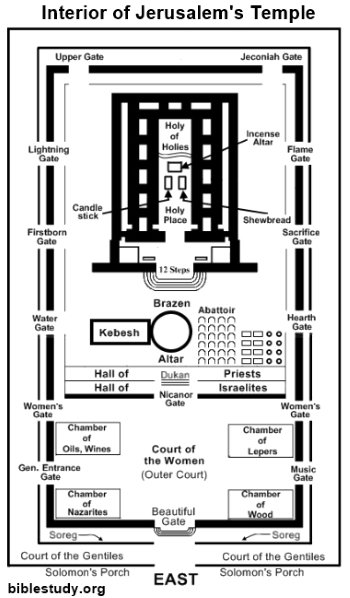Jerusalem's temple, the restoration of which was begun under Herod the Great in 20 B.C. and finished in 65 A.D., is referenced at least 100 times in the New Testament. This magnificent building was the backdrop of several major events not only in Christ’s life and ministry but also in the early ministry of his apostles. The temple, dedicated to the worship of the true God, also played a pivotal role in the life of Paul.
Interactions with Jesus
Jesus' experience and interaction with God's house of prayer begins when he is less than two months old. His parents take him to Jerusalem in order to fulfill the purification requirement of Leviticus 12. In the temple Mary and Joseph make an offering of two young birds and present their newborn son to God (Luke 2:22 - 35).
Mary and Joseph, every year, travel from Nazareth to Jerusalem to keep the Passover and visit the temple. After observing the Feast, when Jesus is twelve, they leave the city thinking their son is with a group of relatives also leaving. Discovering this is not the case, they rush back to the city (Luke 2:41 - 45).
They find Christ engrossed discussing God's law with teachers at the temple. His response reveals that even at a young age he was aware of who his real Father was and had at least a basic understanding of His purpose and calling (Luke 2:46, 48 - 49).

The temple played a pivotal role during Jesus' ministry. Its outer court was the place where He, at the beginning and near the end of his ministry, drove out the "money changers" and others doing business in a place meant for prayer (John 2:13 - 16, Matthew 21:12). He healed many in its location (Matthew 21:14) and frequently taught there (Matthew 21:23, 26:55, etc.). While leaving the temple area for the Mount of Olives he prophesied its total destruction to his disciples (Matthew 24:1 - 2).
False witnesses at Jesus' trial, after his arrest, accused him of threatening to destroy the (Matthew 26:59 - 61). The veil separating the holiest part of the building with the rest of the edifice was miraculously torn in two the moment Christ died (Matthew 27:51).
The Early Church
The early New Testament church, including the ministry of the apostles, had many interactions with the temple. After the resurrection of the Lord, the early church met regularly within its confines (Acts 2:46). It is the place where Peter and John healed a well-known lame man and used the popularity of the act as a means to preach the gospel (Acts 3). In fact, "many signs and wonders" (Acts 5:12) were wrought by the twelve apostles within the walls of the temple.
The first mass arrest of the apostles came after God used them to perform miracles to confirm what they said (Acts 5:15 - 18). The Jewish religious leaders, wanting to quell the popularity of the gospel, threw all of them into a common prison. God, however, sent an angel to free them and give them a special message (Acts 5:19 - 20).
The Life of Paul
Paul's experience with Jerusalem's temple begins early in life. At the age of around twelve, he is taken from his hometown of Tarsus in Cilicia to Jerusalem to begin his religious studies. He attends a Rabbinical school of the Pharisees which is headed up by Rabbi Gamaliel (Acts 5:34), who personally trains the young student of the law (Acts 22:3).
As he grew up Paul became one of the most zealous and devout followers of Judaism (Acts 22:3, Galatians 1:14), and as such visited the temple regularly even as its restoration was taking place.
In Ephesus, toward the end of his second missionary journey, Paul leaves Priscilla and Aquila in the city to travel to Jerusalem. He does this in order to keep the Feast of Tabernacles (Acts 18:18 - 21), the celebration of which centers around the temple and its services.
The outer court of the temple is also likely the place where Paul's appearance in late spring of 58 A.D. stirred up the Jews who hated him and caused a riot (Acts 21:27 - 32). His arrest ultimately leads to him languishing in a Roman prison for more than two years and appealing his case directly before Caesar (see Acts 24 through 26).